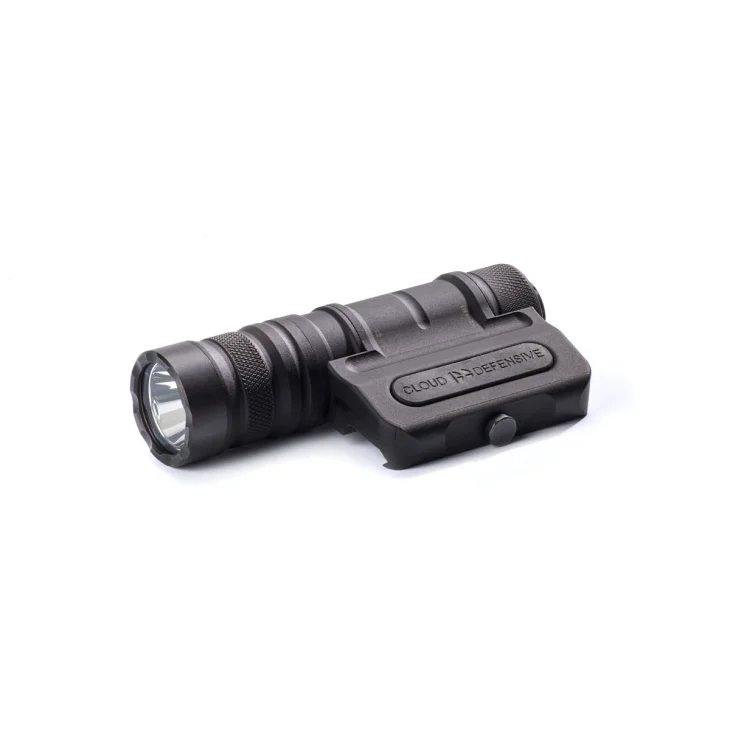
This product is unshippable to your region - check your shipping country
The name says it all, really: The Cloud Defensive OWL is a weaponlight and it's optimized. In this case, the priorities have been set to make the light indestructible, simple, and powerful. It's not the smallest, cheapest, or lightest on the market. It's something else entirely. Reading on might create expensive desires. You have been warned.
- Indestructible and serviceable construction
- Integrated design - simple package
- Ambidextrous and reversible
- Comes with a charger but does not include batteries*.
* Two important things to note here: this light does not fit oversized 68.8 mm batteries such as the Fenixes we sell. A 68 mm battery could fit tightly, anything shorter than that should be good to go. Also, do not use anything else than 18650 batteries in this light.
Top-tier features
The Cloud Defensive OWL has some really well-thought-out features that set it apart from many other choices you might have in mind. In case you're making comparisons, remember to include the mount and pressure switch weights and costs in the comparison because the OWL has both. Also, you may want to ask yourself: does a narrow body behind a large bezel make a light smaller, like really? The stout package comes with heaps of pros:
The interface
The ergonomics of reaching and using the pressure pad are excellent. The OWL is designed to mount on the top of the handguard and to be operated by either hand. Reversing the light to either side of the rifle only puts the bezel where you want it; the switch is always within your reach and functional across the whole rubber, not just some magic spot you have to find.
Operating the light follows the proven and popular logic: Press and hold for momentary action - the light goes off when you release. For constant operation, use a short tap. A strobe function is not included, find another light to use at rave parties.
The beam
Not only does the OWL throw more light on the target but it also has a warmer light temperature that is easier on the eyes and helps pick up details you might otherwise miss. But what's this claim about more light on the target for the same lumens?
The lumen (lm) is the unit of luminous flux and indicates the total output of visible light by the flashlight. Lumens are practically comparable between lights only when the beam pattern is the same. We never compare a lantern with a 360-degree throw to a laser pointer so the amount of lumens usually gives a pretty good idea of what to expect but not always.
The candela (cd) represents the number of lumens per one solid angle. The principle is quite simple: When the light beam is projected at a smaller angle, the light covers a smaller area so it's brighter and the beam length is extended. For the maximum amount of light on the target, look for lots of lumens with a narrow beam, or just a lot of candelas. This is what Cloud Defensive has done with the OWL: concentrate the beam to get light on the target rather than around it.
The simplicity
We all can manage wires but would rather not. The OWL has everything integrated into the body: the attachment, the switch, and the bezel. There's nothing to snag or tear off, and installing is simply a matter of screwing it on a 7-slot length of Picatinny rail with the tailcap tool.
The bezel ring is made of tool steel and comes off by hand to replace the lens - which is stupid thick and unlikely to ever break. The bezel and tailcap twist right off the body and can be assembled in reverse to position the light left or right.
The simplicity has allowed to make the OWL durable almost beyond belief: the level of abuse directed at these lights in the tests is brutal. It's probably more shockproof and waterproof than any other battery-operated piece of equipment you have.
Technical data
- Light output: 1300 lm / 55,000 cd (max)
- Runtime: 85-120 min (powerful illumination), 6 h (usable)
- Power source: 1 x 18650 Li-ion only! (Not included.)
- Finish: Type III Mil-Spec Hardcoat anodizing
- Exceeds ANSI/PLATO FL-1
The maximum light output is achieved with an unprotected Samsung 18650 30Q battery and it provides the shortest runtime. Batteries with a protection circuit provide an output of 1250 lm / 52,000 cd and the longest runtime.
Other specs:
| Spec | Metric | Imperial |
|---|---|---|
| Length | 133 mm | 5.255" |
| Width | 70 mm | 2.76" |
| Bezel Diameter | 35.6 mm | 1.4" |
| Weight (w/o battery) | 281 g | 9.9 oz |
| Weight (w. battery) | 326 g | 11.5 oz |
| Water resistance | IPX8 60 m - 24 h | IPX8 200 ft - 24 h |
Made in USA.
This product is unshippable to your region - check your shipping country